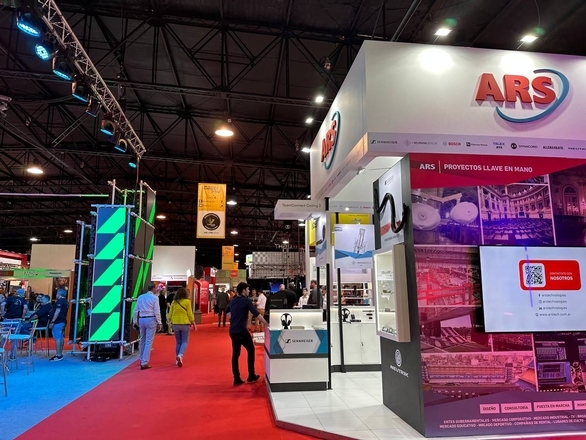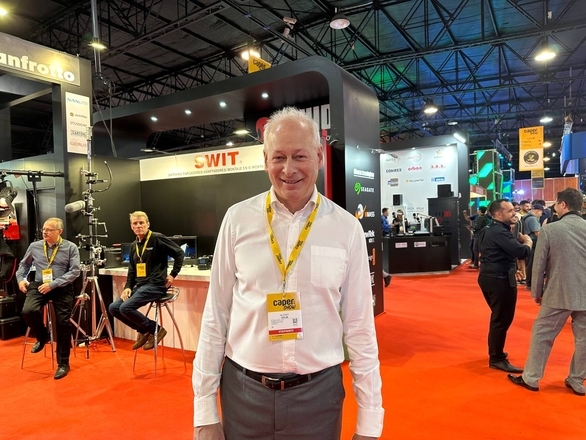Satellite for the Pampas: the Caper Show discusses how the TV market is developing in Argentina
RSCC attended the CAPER Show 2023, which took place from November 7 to 9 in Buenos Aires, Argentina. The CAPER Show is a professional industry event in the media sphere of Latin America, dedicated to issues related to TV broadcasting, cable and satellite television, specialized equipment manufacturing, as well as content creation. This year, the exhibition hosted more than 5,000 professional visitors from Argentina, Chile, Uruguay and Paraguay. The event featured major TV broadcasters such as TVN from Chile, Chilevisión de Chile, TV Ciudad from Uruguay, TV San Luis from the internal regions of Argentina, as well as international media companies like Disney, Artear, Paramount, WBD, Encuentros, and Colsecor. During the exhibition, RSCC delegation held a series of business meetings and negotiations with television companies.
"The discussions at the Caper Show exhibition revealed that in Latin America, television remains one of the main drivers of satellite market development. Talks about the decline in the TV market share are justified for markets such as the United States, Japan, and European countries. In Latin America, as in most countries worldwide, television maintains its leading role in satellite communication. That's why the South American market is crucial for us in terms of the development of international sales: a satellite is indispensable for delivering video content. Our satellite 'Express-AM8' covers whole Argentina, and we are ready to offer customers the best service," said Alexey Volin, Director General of RSCC.
The 31st edition of the Caper exhibition, organized by the Argentine Chamber of Manufacturers and Integrators of Professional Audiovisual Equipment (CAPER), was opened by their chairman, Ricardo Emilio Solari. "I would like to emphasize how important the dialogue between major companies, the government, and small private startups is. Now the media market is struggling in a crisis caused both by the economic consequences of the post-pandemic and difficulties in importing input materials and equipment, however, I am sure we will be able to work out common solutions on the CAPER Show platform within the framework of conferences. The three days of CAPER Show include a comprehensive program of conferences, round tables, workshops and seminars to exchange views and discussions on the new scenario of the industry, new business models and the legal framework for their development," he said.
Argentinian Pay-TV
The Latin American pay-TV market is developing following the same trends as the rest of the world: in large population centers there is a clear shift of subscribers from classic TV services — satellite and cable TV — to streaming and OTT, though regions with underdeveloped infrastructure remain a good point of growth for satellite signal delivery services.
Latin America's pay-TV subscriber base will remain stable with 61 million subscribers, although this is down from a peak of 73 million in 2017. And by 2028, the number of homes paying for IPTV will be 11.5 million, up from 7.9 million in 2022.
As of the end of 2020, Argentina recorded the highest penetration of pay television in Latin America, with 77% of households having access to this type of service. However, pay-TV is distributed very unevenly: in some regions it does not exceed 20%. Two operators — Cablevision and DirecTV Latin America — have concentrated more than 70% of all pay-TV subscribers in Argentina.
Within the period from 2015 to 2020, revenues from pay-TV in Argentina grew by 7.5%, reaching ARS 38.8 billion. The major problem for the industry (as well as the entire economy of the country) is the serious inflation of the national currency, while the growth of pay TV is denominated in that currency. The second problem: high levels of piracy and underreporting. According to speakers at the Caper conference, a group of attackers whose illegal video platform had 85,000 subscribers was detected in Argentina in July 2023.
Argentina's satellite market
Argentina is one of the few countries that not only has its own space industry, but also focusses national programs and national business — primarily communications — on its own resources. Spacecraft developed in the country support the communication business throughout Latin America. At the Caper conference, experts presented a forecast of the Latin American satellite segment volume in 2027 — it will reach $40 billion while Argentina and Brazil were named the main players in this sector.
Argentina's state-owned Arsat operates two Ku-band geostationary satellites, Arsat-1 and Arsat-2 that were launched in 2014 and 2015, respectively. The operator provides services in the United States, Mexico, Venezuela, Canada and Chile. Both satellites were built by the Argentine developer Invap, which was also awarded the contract for the third satellite, Arsat SG-1. This Ka-band satellite is state-funded, and its launch is scheduled for 2025. The satellite is produced in partnership with Turkish Aerospace Industries, and multi-beam antennas for it are ordered from MDA. Additionally, Arsat utilizes capacity from SES-17 and is going to order some capacity from Jupiter-3.
As a state-owned terrestrial television broadcasting operator, Arsat covers about 80% of the country with terrestrial stations, and about 20% with the Arsat-1 satellite. The free state package includes 16 TV channels and has recently been expanded with University TV which aims to broadcast content focused on culture, education and science, with an emphasis on local and regional realities.
At the Caper Show conference, Arsat Vice President Guillermo Rus said that the operator's main goal is to connect everyone in the country and emphasized the need to provide not only a satellite infrastructure but also the service. As far as he knows, as of May 2023, Arsat's services were used by about 900 internet providers, most of them served fewer than 2,000 subscribers and had not previously had access to the infrastructure, the trunking channels network that allows for Internet access services.
As part of the program of the Ministry of Transport and Telecommunications to connect the population to free and open TV, Arsat, in cooperation with local authorities, provides residents of a remote region with satellite kits to receive a free package of 12-20 TV channels.
Using SES-17 capacity Arsat is implementing programs to connect schools, medical institutions and settlements with a population of less than 500 people. The national Connect Schools program implies connecting and providing free TV packages to all schools in the country within three years and providing Internet access to more than 10 million students.



